
The Gaboon viper is a viper species found in the rainforests and savannas of sub-Saharan Africa. Like all other vipers, it is venomous. It is the largest member of the genus Bitis, and it has the longest fangs of any venomous snake – up to 2 inches (5 cm) in length – and the highest venom yield of any snake. No subspecies are recognized.

Bitis nasicornis is a venomous viper species found in the forests of West and Central Africa. This large viper is known for its striking coloration and prominent nasal "horns." No subspecies are currently recognized. Common names: butterfly viper, rhinoceros viper, river jack.

Atheris squamigera is a venomous viper species endemic to west and central Africa. No subspecies are currently recognized.

Atheris is a genus of venomous vipers known as bush vipers. They are found only in tropical subsaharan Africa and many species have isolated and fragmented distributions due to their confinement to rain forests. In an example of convergent evolution, they show many similarities to the arboreal pit vipers of Asia and South America. Seventeen species are currently recognized.
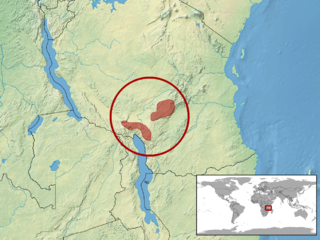
Atheris barbouri is a small and rare terrestrial species of viper endemic to the Uzungwe and Ukinga mountains of south-central Tanzania in Africa. No subspecies are recognized.
Montatheris is a monotypic genus created for the venomous viper species, M. hindii. This is a small terrestrial species endemic to Kenya. There are no subspecies which are currently recognized as being valid.
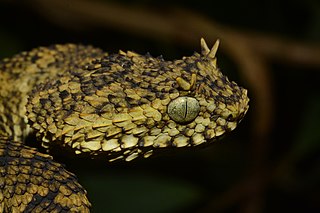
Atheris ceratophora is a venomous viper species endemic to a few mountain ranges in Tanzania. This used to be the only horned, arboreal viper known from Africa, until the discovery in 2011 of Atheris matildae, also found in Tanzania. No subspecies are currently recognized.
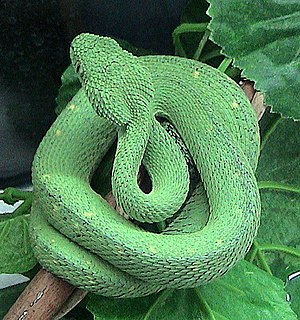
Atheris chlorechis is a venomous viper species found only in the forests of West Africa. No subspecies are currently recognized.

Atheris hispida is a venomous viper species endemic to Central Africa. It is known for its extremely keeled dorsal scales that give it a bristly appearance. No subspecies are currently recognized. Common names include rough-scaled bush viper, spiny bush viper, hairy bush viper, and more.
Atheris katangensis is a venomous viper species found in the eastern Democratic Republic of the Congo and in Zambia. No subspecies are currently recognized.

Atheris nitschei is a species of highly venomous snake, a viper in the subfamily Viperinae of the family Viperidae. The species is native to Africa. There are no subspecies that are recognized as being valid.
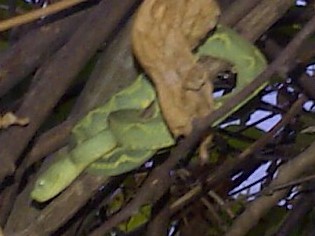
Atheris rungweensis, commonly known as the Rungwe tree viper, Mt Rungwe bush viper, and Rungwe leaf viper, is a species of venomous viper found in East Africa.
Causus maculatus is venomous viper species found mainly in West- and Central Africa. No subspecies are currently recognized. Common names include forest rhombic night adder, West African night adder and spotted night adder.
Causus bilineatus is a venomous viper species endemic to south central Africa. No subspecies are currently recognized. Common names include lined night adder, two-lined night adder, and two-striped night adder.
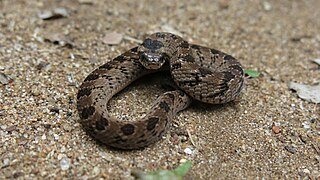
Causus defilippii is a species of venomous snake in the family Viperidae. The species is endemic to East and Southern Africa. There are no recognized subspecies. Its common name is snouted night adder.
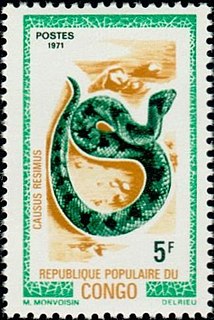
Causus resimus is a venomous viper species found in isolated populations distributed across tropical Africa. No subspecies are currently recognized.

Bothrops taeniatus, the speckled forest-pitviper, is a species of pit viper found in the equatorial forests of South America endemic to Colombia, Ecuador, Peru, And Brazil. The specific name, taenia, is derived from the Greek word, tainia, meaning ribbon bandage or stripe, in reference to the slender body. Two subspecies are currently recognized, including the nominate subspecies described here.

Gloydius ussuriensis is a venomous pitviper species endemic to far east Russia, northeastern China and the Korean Peninsula. No subspecies are currently recognized.
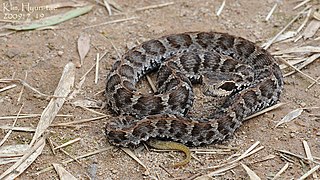
Gloydius brevicauda is a venomous pitviper species endemic to China and the Korean Peninsula.
Bothrops pulcher is a venomous pitviper species found in South America. The specific name is Latin, meaning "beautiful", in reference to the color pattern. No subspecies are currently recognized.














